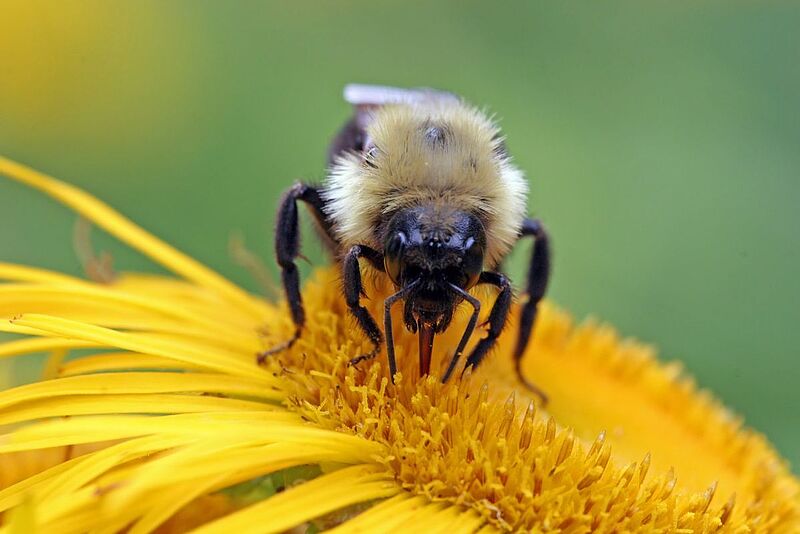Bumblebees can play a key role in strengthening pollination programs as they are highly adapted to Canadian weather conditions. Compared to honeybees, they will fly earlier in the season, earlier and later each day, as well as in adverse weather conditions like rain and overcast skies. Bumblebees will also pollinate in much cooler temperatures compared to honeybees, due to their larger body mass and insulating hair (pile).

Commercially reared bumblebee species will forage at temperatures as low as 3-4C (37-39F) and will reliably pollinate crops starting around 10C (50F). For comparison, honeybees usually do not become active until around 16C (60F). This can cause problems, as in primary blueberry production areas, like British Colombia, Quebec, New Brunswick, Nova Scotia, and PEI, the typical pollination temperatures average between 3-15C (37-55F). Despite their ability to pollinate in much cooler conditions, bumblebees also perform even better in warmer conditions with peak pollinating flight activity between 25-27C (77F-81F).
When introducing QUADs (commercial bumblebee hives) into your field, remember that bumblebees differ significantly from honeybees and require distinct management strategies to leverage their strengths effectively. Proper hive placement is crucial to maximize the benefits of using bumblebees and minimize any adverse factors. Incorrect placement can lead to severe outcomes, such as hives being destroyed by nearby honeybee colonies or reduced pollination activities due to improper positioning within the crop.
Key Factors to be Aware of When introducing our Quads into your Field, Orchard, or Bog:
1. Delivery Timing: Bumblebees should be placed in the field just before the first flower cracks. There will be many alternative food sources, such as dandelions or tree pollen for them to forage on until the crop's blooms open. Getting bumblebees in early will ensure they have the full pollination window to do their work and will provide a buffer in case the colonies get mildly damaged by shipping, as they will spend a few days repairing the hive before they start foraging for pollen.
Note: 5-7 days prior to a flower’s opening is a good delivery window to aim for.

2. Distance from Honeybees: Honeybees can destroy bumblebee colonies if placed too close. At a minimum, this will divert their attention from pollination as they try to guard their colony from honeybees trying to steal their nectar reserves. Always make sure to position Quads at a minimum off 100 meters away from honeybee hives.
3. Colony Spacing: Though bumblebees will forage and pollinate at temperatures as low as 3-4C (37-39F), they tend to stay within 100m of the colony at these low temperatures. As temperatures climb into more optimal pollination ranges (>10C (50F)), the bumblebee’s forage range will increase to the 300–400-meter range. Honeybees, by comparison, typically forage up to a km away from the hive, so while honeybees can all be placed in one corner of the field, bumblebees must be dispersed throughout the field. Quads need to be spread out as much as possible in a checkerboard style pattern around their 300–400-meter radius foraging patterns. In areas where bears are an issue, quads may need to be grouped to minimize electric fencing costs.
Note: Try to keep a maximum of 4 Quads per fenced area.

4. Sun or Shade: Because bumblebees are highly adapted to cool conditions, the Quads never need to be placed in direct sunlight to warm up. Even on chilly spring mornings, the colony maintains optimal brood temperatures through thermoregulation, with bees actively generating and conserving heat inside the hive. Instead of seeking warmth, it’s far more important to protect the colonies from overheating. That’s why Quads should always be placed in shaded areas, near a tree line, or under Koppert’s specially designed Quad Shades. Providing shade helps reduce stress on the colony and ensures longer, more efficient foraging throughout the day—especially during warm spells or in sun-exposed crops.
5. Elevated: Quads should always be elevated above the ground on a pallet, insulation board, or something similar to minimize loss of heat through exposure to the cold ground. This will help make sure the colonies stay warmer, which increases the daily pollination window.

If all these steps are followed, the Quads strengths will be maximized, allowing the colonies to do their job properly and efficiently in the specific time needed.

